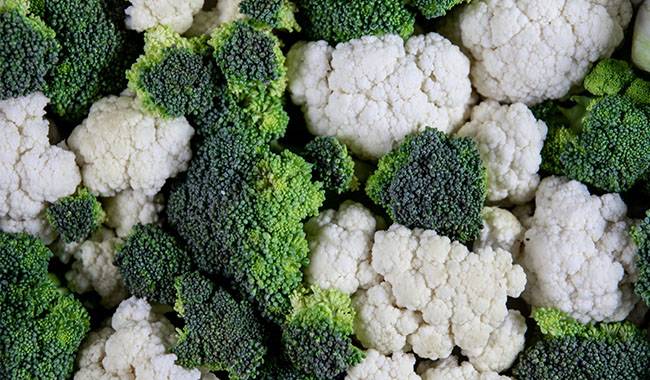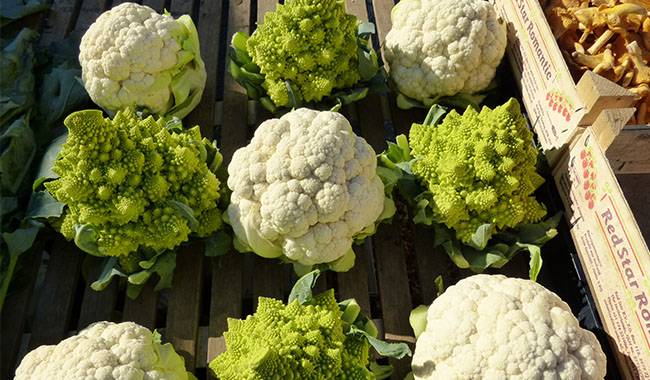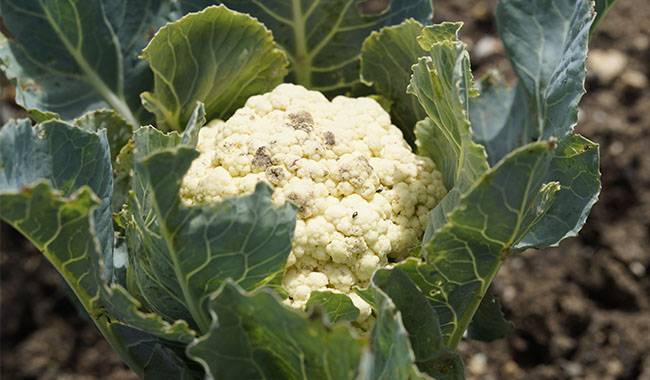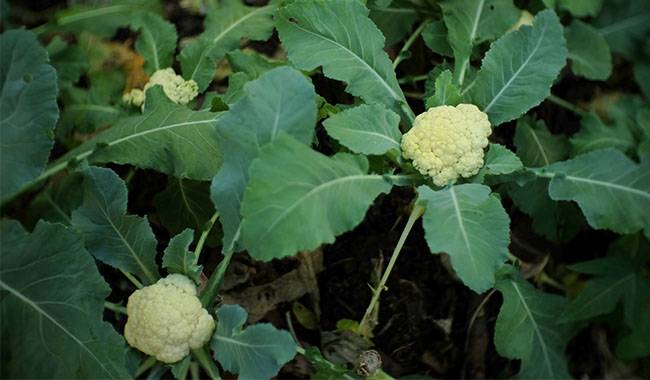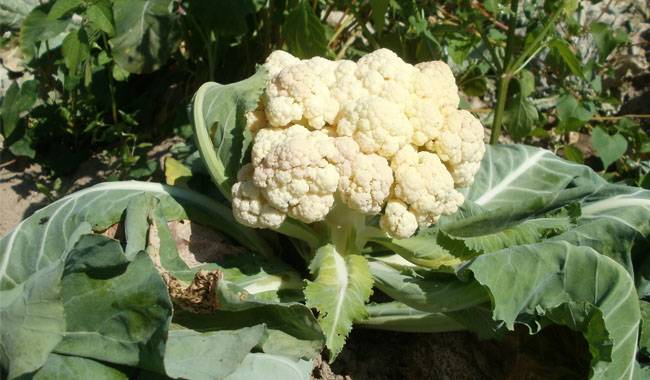
Humans have been growing and using cauliflower as food since ancient times. As a vegetable crop in the European diet, cauliflower appeared in the 11th century, but only recently has cauliflower begun to be used as a food. Its flavor and nutritional quality make cauliflower a possible leader in the line of vegetable crop foods that a person needs.
If you grow cauliflower from seedlings, you can already harvest it in June. Cauliflower contains plant proteins, carbohydrates, amino acids, and nitrogenous compounds easily absorbed by the body. It is hypoallergenic (free of allergenic elements) and practical, which is why it is recommended as a preferred supplement for infants.
Cauliflower activates the process of red blood cell formation and helps to lower blood sugar levels. In the elderly, cauliflower reduces the fragility of bones, and in children, it contributes to their growth and strengthening. Unfortunately, it is impossible to calculate all the positive properties.
But even the listed shows – growing cauliflower is a necessary vegetable in the garden. What prevents gardeners from obtaining large, high-quality, and tasty cauliflower heads inflorescences?
CAUSES OF FINE CAULIFLOWER
Variety of cauliflower
One of the main causes of cauliflower becoming shallow is the wrong variety. Most cauliflower varieties come from abroad, and even the zoned ones cannot tolerate the sudden temperature changes of the American climate in spring and summer.
The sowing period of cauliflower
Affects the number of flower buds, the thickness of flower buds, and the sowing period. Cauliflower is a short-day plant. There are 13-14 hours in a day, mainly when the leaves are developing. In addition, this culture does not tolerate even temporary shade. Plants develop properly in bright light throughout the light day. Otherwise, they do not form developed inflorescences.
Optimal temperature of cauliflower
cauliflower needs moderately warm temperatures. The optimal temperature for inflorescence development is within 62-64°F (17-18°C). On cold nights, inflorescence development slows down, but they get larger, while on hot nights at 75°F (25°C), they remain small and look loose and sparse, with each flowering branch unopened buds separating from the involucral stem. The inflorescence looks like a faded, scattered bouquet.
Nutrition of cauliflower
The thickness of the inflorescence of the culture is influenced by the supply of nutrients. Cauliflower absolutely does not tolerate “starvation” and excess nitrogen, violation of the ratio of essential nutrients, lack of organic matter in the soil. In the case of overfeeding, only huge cauliflower leaf masses are formed, which cannot be used for food. In the absence of nutrients, the plant forms buds that never open but only disintegrate and hang loosely from individual small and incomplete inflorescences.
Watering cauliflower correctly
Violation of the irrigation regime has a negative effect on the formation of cauliflower leaves and the development of ovaries. Early soil drying is almost impossible to correct by heavy watering during the rest of the growing season.
HOW TO GET A GOOD CAULIFLOWER CROP?
Preparing cauliflower seeds
Harvesting starts with the seeds. It is more practical to buy cauliflower seeds than to grow them yourself. Buy seeds only from verified sellers.
The package should have the following data on it.
- The name of the variety or hybrid.
- Zoning instructions.
- The year of propagation and how long viable seeds will be stored
- Approximate date of sowing of young plants and open field crops in the area
- The approximate maturity conditions of the variety (early, medium, and late) and harvest.
Buying cauliflower seeds eliminates the need to prepare for sowing, which saves a lot of time.
Which cauliflower variety should I choose?
The cauliflower varieties differ in appearance depending on the color of the mature inflorescence. However, the color does not affect the quality of the product but depends on the preference of the gourmets. Some prefer snow-white inflorescences. Others prefer purple or soft beige.
For Dhaka plots, it is best to buy experienced domestic cauliflower varieties obtained in the region or the climatic conditions of a specific area of the region. It is best to plant early or mid-ripening varieties, which will develop a finished product in 70-100 days.
Late maturing cauliflower varieties, especially in short summers, may not mature and will need to be transplanted into a greenhouse or undercover. This is additional work, requiring the skills of a more experienced gardener and a heated greenhouse.
Given the entire developmental cycle of cauliflower, which takes more than 100 days even for early varieties, it is most often grown by budding. The sprouting period allows for early (sometimes as early as June) yields.
Breeders offer new varieties and hybrids of cauliflower every year with improved qualities, which you can choose from the catalog.
PREPARING THE SOIL FOR CAULIFLOWER
cauliflower is a special vegetable crop. The plant does not tolerate low fertile, dense, heavy, highly acidic clay soils. After assigning a bed for cauliflower in the crop rotation, it is necessary to carry out all work related to soil preparation from autumn onwards. To deoxygenate the soil from autumn onwards, lime or dolomite powder should be used. The optimal soil acidity for cabbage is pH 6.5-7.5.
Fill the soil of the cauliflower with mature humus or compost or readily available bio-humus. Depending on the condition of the soil (its fertility and type), normalizing the water and air exchange process, the amount of organic matter can be 1-3 buckets per 11 square feet.
Seedlings and cauliflower seedlings are very sensitive to the lack of essential nutrients and trace elements, especially boron, molybdenum, and magnesium. Therefore, starting in the fall, along with organic fertilizer, you can apply nitroprusside at a rate of 60-70 grams per 11 square feet.
You can apply half of the nitrocellulose from autumn and supplement with kemera, which contains the necessary trace elements, before planting cauliflower seedlings in spring. You can independently choose to use a fall application of mineral acids depending on soil conditions.
SOWING TIME OF CAULIFLOWER BY REGION
Regardless of the harvesting method (by germination or direct sowing in the open ground), the sowing time recommended by the agronomist of cauliflower cultivation must be followed.
If cauliflower is grown by germination, it is best to sow in peat pots or other trays, but this will not interfere with the root culture when planted in a permanent place.
It is very important that the growth and development of the plant are not allowed to stop during the cultivation of the seedlings. The prolonged settling of the root system when planted in the ground can suspend the development of the culture, and this interruption in time can eventually lead to the formation of small heads.
PLANTING CAULIFLOWER SEEDLINGS
In areas with short warm periods, it is better to plant cauliflower seedlings in the open ground or under light cover at the age of 50-60 days so that the plant spends less time in the risk zone (temperature fluctuations, etc.).
cauliflower seedlings should be planted in a permanent place only if they are absolutely healthy, at least 35-40 days old, 6-7inch (15-18 cm) tall, with well-developed roots, many small growing roots, 3-5 well-developed leaves, and dark green color. Seedlings that are elongated, pale in color, and overgrown will not form good large heads.
For cauliflower, beans, bulbs, and pumpkins are good predecessors. Before planting, it is best to add 2-3 tablespoons of ash to each hole. It repels pests and acts as a micronutrient feed, which is necessary for seedlings in the first days of growth.
The germination pattern for rows of cauliflower seedlings is 20x10inch (50×25 cm). cauliflower planting is done on warm cloudy days when the sun is hidden by clouds. Place the plant in the planting hole until the first true leaves. After planting, be sure to water the plant below the roots with a bio fungicide solution. Plant cauliflower buds for 2-3 days (no more), shading them from direct sunlight with some material, but not with a film.
SEEDLESS METHOD OF GROWING CAULIFLOWER
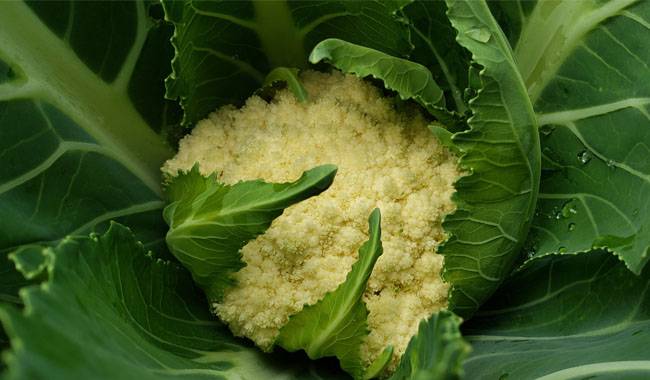
When growing to sprout less cauliflower in suitable climatic conditions, sow seeds into the ground in a layer of 4-8inch (10-20 cm) where the roots reside with the soil warmed to no less than 57-60°F (14-15°C) and the air 62-66°F (17-18°C).
Leave a distance of 16-24inch (40-60 cm) between rows. The first breakthrough (picking) of cauliflower is shown at the stage of 2 true leaves. A distance of 4-6inch (10-15 cm) is left between plants. Weak and thickened plantings are pulled out.
At the stage of 5-6 leaves of cauliflower, the final formation of the plant density is carried out. The cutting distance is 8-10inch (20-25 cm), sometimes up to 12inch (30 cm) (on highly fertile soil and strong high growing varieties with larger above-ground parts). The soil should be well moistened before breaking through the cauliflower. If there is free space and the roots of the uprooted plants are not damaged, you can replant these plants into the free space.
There is no difference in the care of seedless and seeded crops after the final development of standing density.
CARE DURING CAULIFLOWER CULTIVATION
Regardless of the method used to grow cauliflower (via sprouts or direct seeding in the ground), care includes monitoring and staying within the recommended range of moisture, light, and nutrient availability, as well as timely prevention of pests and diseases. After dressing, loosen the soil beneath the plant and bury it in the ground or (less painful for the plant) sprinkle the soil on the stem until the first leaves. Mowing or sprinkling should be combined with the first and second plant feeds.
WATERING CAULIFLOWER
cauliflower is a moisture-loving plant and needs plenty of water throughout the growing season. During the development of cauliflower, there are 2 periods when water is particularly needed, these are the rosette formation and the setting cabbage stage. Soil moisture should not be less than 75-85% (soil that does not stick in your hands but also does not crumble when you open your palms and remains dense, not clumpy soil).
Even short-term soil dryness can negatively affect the development of cauliflower inflorescences and lead to the crushing of cauliflower heads. Water with warm distilled water 1-2 times a week to remove chlorine (if any). When watering with cold water (well water, tap water, and water from other sources), the soil temperature drops sharply and will affect the formation of future plant head size.
The roots of cauliflower are close to the soil surface, so it does not always make sense to loosen the soil and it is better to cover it after watering. Don’t forget to spray the plants with water in hot weather, and spray with mist.
FERTILIZATION OF CAULIFLOWER
Given the high demand for nutrients in the crop to form a high-quality harvest, additional fertilization is required. cauliflower is very responsive to organic nutrients, so it makes sense to alternate fertilization with organic and mineral fertilizers. When fertilizing, you should always remember that if you “feed” too much, the culture will form lush leafy bouquets and you will not get heads with tasty inflorescences.
The cauliflower does not tolerate excessive nitrogen fertilizers, so in feeding, nitrogen fertilizers can appear before the formation of heads. It should not be done later so that nitrates (or nitrites) do not accumulate in the edible part of the culture. It is advisable to provide micronutrients to the plants. They will strengthen the immunity of the plant and serve as protection against pests and diseases. Spend 2-3 months feeding with the basic elements of micronutrient nutrition. Cauliflower varieties with a long growing season should be fed with additional micronutrients.
The feeding program can look like this.
First fertilization of cauliflower
The first feeding of cauliflower should always contain nitrogen to stimulate the development of leaf mass, which is essential for photosynthesis. The first fertilization is done after 10-12 days with a solution of organic fertilizer with added trace elements. The solution is prepared in the ratio of 1:10 for cow manure and 1:15 parts of water for poultry manure.
If organic fertilizers are not available on the farm, they can be purchased inappropriate stores – dry granulated poultry manure, liquid extract of cow or horse manure, etc. In the initial stage, cauliflower plants need boron, molybdenum, magnesium, and manganese to lay eggs and develop inflorescences. You can buy them at the store and add them to an organic solution, dissolving them according to the recommendations.
If there is no possibility to feed the plants with organic fertilizers, you can make Kemira, terrifies, or master in the dose of 60-70 g/2.5 Gal (10 liters) of water. The watering is done under the roots of the cauliflower, not in the nutrient solution on the ground. These fertilizers contain trace elements. It is necessary to mulch the soil after each irrigation to slow down the evaporation of water and crusting.
If the above fertilizers are not available, you can prepare a solution of the same dose of nitroglycerin with trace elements in it.
Second fertilization of cauliflower
The second feeding of cauliflower is done at the stage of 5-7 leaves. Apply azofoska or other compound fertilizer at a rate of 50-70 grams per 2.5 Gal (10 liters) of water, or spread this dose every 11 square feet under irrigation. At the second application, 1 gram of boron and molybdenum must be added to the nutrient solution.
Third application of fertilizer cauliflower
The third fertilizer application is made at the head formation stage (about the size of a large walnut). The heads of cauliflower begin to form when 7-9 covered leaves unfold. They are the food stores for the developing inflorescence. These leaves should not be cut off. They eventually give all the nutrients to the inflorescence, turn yellow, and fall off.
Make a phosphorus and potassium fertilizer of 30 and 40 grams per 11 square feet, respectively. You can fertilize with any other complete fertilizer, but with a minimum amount of nitrogen.
During this period, you can again feed the cauliflower with a mixture of organic and mineral fertilizers. Dilute the cowpeas at a ratio of 1:8, adding one tablespoon of ammonium nitrate and calcium superphosphate per 2.5 Gal (10 liters) of the solution, or one tablespoon of nitrogen and one tablespoon of calcium superphosphate and potassium sulfate for dessert.
HOW TO COVER THE GROWING INFLORESCENCE OF CAULIFLOWER?
Once the head of the cauliflower begins to set, arrange the “hut” from the rosette of 3-4 leaves. Leaves are tied or otherwise pinned to the inflorescence. Some gardeners break the leaves apart and let them lie on top of the young inflorescence. If the growing cauliflower inflorescence is not covered during this time, it will lose its white color in the light and begin to disintegrate into separate flower buds.
After the head setting stage, stop fertilizing the cauliflower so that nitrates/nitrites do not accumulate in the produce.
HOW CAN I TELL IF CAULIFLOWER IS MATURE?
A fresh, mature cauliflower bud is heavy, firm, and resilient. Individual inflorescences break off in a crunch. The leaves framing the inflorescence should be dark green, fresh, and firm.
The cauliflower has lusterless leaves, loose inflorescences, individual buds that bend in different directions, and black spots on the leaves and stems, indicating poor quality. You cannot make delicious food from such products.
More related information about growing cauliflower plants




